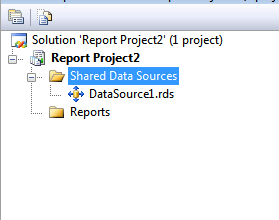- Passing Data from Output Data
- Pass the Query FilterData
We will look at an example for Drill Down Report Example and Passing paramaters to it. Below Two Simple Procs I created in the Database
STEP 1
CREATE PROC TestProc1
(
@Param1 INT,
@Param2 INT
)
AS
BEGIN
SELECT 100 AS 'Result'
RETURN 1
END
CREATE PROC SUBProc2
(
@VALUE1 INT,
@VALUE2 INT,
@Value3 INT
)
AS
BEGIN
SELECT @VALUE1 as 'Outout1',@VALUE2 as 'Output2', @Value3 as 'Output3'
RETURN 1
END
STEP2
Now I am going to create Report from Proc TestProc1. In the SSRS Report Server Project I created a blank report, Created DataSet and Input Parameters. I would explain it step-by-step below
STEP3 - Next Step is creating dataset using proc TestProc1
STEP 4 - For the input param create a Dataset and assign values as defined below

STEP 5 - Parameters and DataSet would be like below

STEP6 - Assign Created Dataset for Parameters as below

STEP 7 - Assigning Default value for Parameter param1

STEP 8 - Assigning input for Param2

STEP 9 -Now for Second Report using Proc SubProc2 Dataset Creation as below

STEP 10 - After providing dataset Input parameter would be listed as below when you specify Refresh Fields in Step 9

STEP 11 - DataSet creation for parameters for Report2

For Second Parameter Data Set creation

STEP 13 -Assigning Dataset for parameters

STEP 14 - This is the step where we assign Sub Report. Under Output->TextBox Properties->ReportName and Parameters
For Passing Filter Criteria we specify [@Param1], for passing current result we specify [Result]

Its pretty lengthy blog but last step is the important one. It worked finally.
(
@Param1 INT,
@Param2 INT
)
AS
BEGIN
SELECT 100 AS 'Result'
RETURN 1
END
CREATE PROC SUBProc2
(
@VALUE1 INT,
@VALUE2 INT,
@Value3 INT
)
AS
BEGIN
SELECT @VALUE1 as 'Outout1',@VALUE2 as 'Output2', @Value3 as 'Output3'
RETURN 1
END
STEP2
Now I am going to create Report from Proc TestProc1. In the SSRS Report Server Project I created a blank report, Created DataSet and Input Parameters. I would explain it step-by-step below
STEP3 - Next Step is creating dataset using proc TestProc1

STEP 5 - Parameters and DataSet would be like below

STEP6 - Assign Created Dataset for Parameters as below

STEP 7 - Assigning Default value for Parameter param1

STEP 8 - Assigning input for Param2

STEP 9 -Now for Second Report using Proc SubProc2 Dataset Creation as below

STEP 10 - After providing dataset Input parameter would be listed as below when you specify Refresh Fields in Step 9

STEP 11 - DataSet creation for parameters for Report2

For Second Parameter Data Set creation
STEP 12 - Assigning Parameters and Dataset

STEP 13 -Assigning Dataset for parameters

STEP 14 - This is the step where we assign Sub Report. Under Output->TextBox Properties->ReportName and Parameters
For Passing Filter Criteria we specify [@Param1], for passing current result we specify [Result]

Its pretty lengthy blog but last step is the important one. It worked finally.





















































